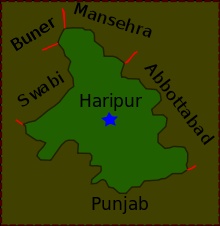
Haripur ("The Town of Hari or God") is a district in the Hazara region of Pakistan with an altitude of around 610 metres (2,000 ft) above sea level.As of 2005, Haripur District has the third highest Human Development Index of all the districts in the Pakistan.
Administration
The District of Haripur was a Tehsil,or sub-division, of Abbottabad District,until 1992 when it became a district in its own right.The district is presently (2010–2011) represented in the provincial assembly by four elected MPAs.One of those four MPA's is elected to the National/Federal Assembly.Currently, Haripur District is divided into two tehsils, further subdivided into 44 Union Councils of which 15 are urban Union Councils
Ali Khan, Khyber Pakhtunkhwa
Bagra, Khyber Pakhtunkhwa
Baitgali
Bakka, Khyber Pakhtunkhwa
Bandi Sher Khan
Barkot, Khyber Pakhtunkhwa
Beer, Khyber Pakhtunkhwa
Behki,
Bherrary
Breela
Darwesh
Dheendah
Dingi
Ghazi, Khyber Pakhtunkhwa
Haripur Central
Haripur North
Haripur South
Hattar
Jabri
Jatti Pind
Kalinjar, Khyber Pakhtunkhwa
Khalabat Township
Khanpur, Khyber Pakhtunkhwa
Kholian Bala
Kot Najeebullah
Kotehrra
Kundi, Khyber Pakhtunkhwa
Landarmang
Mankrai
Maqsood
Najifpur
Nara Amaz
Pandak, Pakistan
Panian
Pind Hasham Khan
Pind Kamal Khan
Qazipur
Rehana
Sarai Saleh
Serai Niamat Khan
Sikandarpur
Sirikot
Sirya
Tarbela
Tofkian
Notable people
Bostan Khan Tarin, 18th-century warriorKhan Sahib Abdul Majid Khan Tarin, barrister, MLA and senior philanthropistField Marshal Ayub Khan, President of Pakistan (1957 to 1969)Pir Sabir Shah, Chief Minister North-West Frontier Province (1996 to 1997)Gohar Ayub Khan, former Speaker of the Pakistani National AssemblyOmar Ayub Khan, former federal minister of state for financeRaja Sikander Zaman, former chief minister of the North-West Frontier Province.Mohammad Abdul Ghafoor Hazarvi, former President Jamiat Ulema-e-Pakistan and Pasban Khatme Nabuwwat
Natural resources
The area is rich in natural resources and contains two important reservoirs, the Tarbela Dam and Khanpur Dam.
Geographically, it is the gateway to Hazara, the Hazara Division, and the Pakistani capital Islamabad.
BoundaryGeographically,
the district borders Abbottabad District to the north east, Mansehra District in the north-east, the Punjab to the south east, the Buner to the north-west and Swabi to the west. The Federal Capital of Islamabad is also adjacent to the district in the south.
Demographics
As of the 1998 census, Haripur's population was 692,228, and by 2005, it was estimated to have increased to 803,000. 12.0% live in urban districts with the remaining 88.0% residing in rural areas.
The population is spread over an area of 1,725 square kilometres (666 sq mi), resulting in a density of 401.3 persons per km².[4] This compares to an average density of 233 persons per km² in Hazara as a whole. The average household size of the district is 6.6 persons compared to 8 at the provincial level. Agriculture is the predominant livelihood of the population while the total arable area is 77,370 acres (313.1 km²).
Languages
Hindko and Pashtu are the major languages spoken in the district.
Literacy rate
The literacy rate in the Haripur district is 53.7%, substantially higher than the literacy rate in the province of Hazara, which is 35.2%. The female literacy rate is only 37.4% compared to male literacy of 63.6%, and urban literacy rate of 69.7% is significantly higher than the rural rate of 51.4%.
Education
Haripur District has two government funded post graduate colleges, providing higher level education, as well as four degree colleges for girls. Haripur University was established in 2012.
In 2000–2001, Haripur had 907 government primary schools, including 656 for boys and 251 for girls. In addition to government primary schools, 166 mosque schools were also in the district. The primary school population (5–9 years) consisted of 101,670 students, of which 52,240 (51.38%) were boys and 49,430 (48.61%) were girls.
The district had 83 middle schools (56 for boys and 27 for girls), during 2001.
Industries
There are many factories of various sizes on the Hatar Industrial Estate, and the presence of these industries means the district plays an important role in national economic development. One of the most prominent industries in the Haripur district is known as Cactus Fertilizer (formerly Pak-China Fertilizers) which is the largest producer of phosphate fertilizer in Pakistan.
Haripur's role in the agricultural field is also important. The district provides fruit and vegetables not only to Peshawar but also to Islamabad and the Punjab.
References
Nalwa, V. (2009), Hari Singh Nalwa — Champion of the Khalsaji, New Delhi: Manohar, pp. 77-104, ISBN 81-7304-785-5.
Jump up ^ Nalwa, V. (2009), Hari Singh Nalwa — Champion of the Khalsaji, New Delhi: Manohar, pp. 224-5, ISBN 81-7304-785-5.
Jump up ^ 'The Rock Aornos from Huzara' - British Library Online Gallery
Jump up ^ Information Pakistan - Districts of Pakistan



